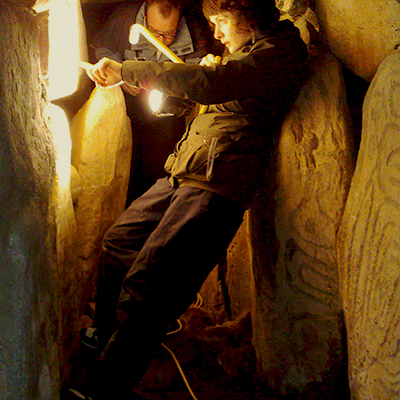Launch of new four-year project exploring passage tomb societies
In March 2018, Dr Jessica Smyth was awarded €600,000 by the Irish Research Council for her project (opens in a new window)‘Passage Tomb People’ - part of the prestigious (opens in a new window)IRC Laureate Awards Scheme 2017/18. ‘Passage Tomb People’ was one of 36 applications recommended for funding under the scheme, with a total of 258 eligible applications assessed and 71 shortlisted for interview. In September 2018 the project officially launch and will run for four years, to August 2022.

Built more than 5000 years ago, passage tombs represent some of the greatest achievements of human engineering and creative expression, involving the transport and erection of stone blocks weighing up to 180 tonnes, elaborate sequences of stone carving, and precise astronomical alignments. Hundreds of these monuments dot the Atlantic coastline, and some of the very largest passage tombs are clustered in ceremonial complexes.
While scholarly interest in megalithic architecture is as old as the discipline of archaeology itself, we know relatively little about the nature and structure of the prehistoric communities that raised passage tombs. Some of the most basic questions remain unanswered: who were these builders, and what worlds were they part of? What types of resources underpinned these staggering feats of engineering? Passage Tomb People aims to identify the social drivers of passage tomb construction along the Atlantic Façade, drilling down into the archaeology of three key zones – Ireland, North Wales and Orkney.
Erected several centuries after the arrival of farming in each region, passage tombs may be responses to economic stress or, equally, the result of surplus and increasing social competition. The ‘Passage Tomb People’ research team, led by Dr Smyth, will probe the connections between monument construction and changes in farming practice, diet and environment, testing whether similar factors triggered similar behaviours in each study area. This will be achieved through large-scale programmes of molecular and isotopic analyses tailored to the kinds of archaeological evidence that survive in each region, such as pottery sherds and bone fragments. Specific lines of investigation involve (i) species identification of highly fragmentary bones via collagen peptide ‘fingerprinting’, (ii) dietary assessments via carbon and nitrogen stable isotope analyses of human skeletal remains and food residues in pottery, (iii) strontium isotope analyses to investigate mobility and connectivity, and (iv) systematic radiocarbon dating of bone and pottery lipids to refine understanding of monument construction and use.
Project website: (opens in a new window)https://passagetombpeople.com/